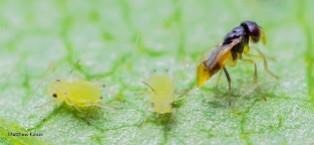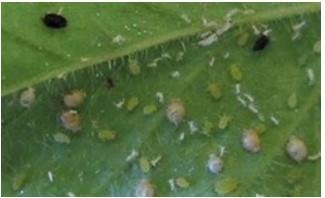By Phyllis Bongard
Sometimes organisms in our fields are already helping us with pest control. Dr. George Heimpel, University of Minnesota entomologist, joined Extension Educator Anthony Hanson for a discussion on the types of organisms that can aid you in managing soybean aphid in the March 23 session of Strategic Farming: Let’s talk crops!
The hunt for biological control agents
The soybean aphid, a major pest of soybean, invaded the U.S. from eastern Asia in 2000. Shortly after its arrival, Dr. Heimpel and other entomologists traveled to Asia to hunt for natural predators of this pest. Their hope was that they might be able to bring biological control agents back to the United States for release in soybean fields.

Parasitic wasp attacking an aphid
They found about 20 species of tiny parasitic wasps, called parasitoids, that were attacking the soybean aphids in their native range. Some of these went through extensive safety screening in the USDA quarantine lab on the UM campus. Out of this very long process, researchers found two species, Binodoxys communis and Aphelinus glycinis, that were highly specialized, meaning that they attacked only the soybean aphid. Unfortunately, these two species weren’t able to get established in Minnesota. Other parasitoids were tested and rejected as biological control agents, because they were broad generalists that could attack our native aphid species.
Aphelinus certus (A. certus)
Aphelinus certus was one of the parasitoids that had been tested and rejected in the Minnesota quarantine lab because it was a broad generalist. However, it was accidentally introduced in the Pennsylvania area around 2005. It arrived in Minnesota in 2011 and quickly became widespread and persistent.
How does A. certus attack soybean aphid?
This tiny parasitic wasp searches out the soybean aphid where it lays its eggs. As the eggs hatch, the emerging larvae feed on the inside of the aphid, killing it and eventually leaving a blackened “mummy,” while other parasitoid species leave behind white mummies.

Soybean aphids and parasitized, darkened aphid
mummies.
Population trends
Between 2011 and 2021, soybean aphid density over the season - or cumulative soybean aphid days - has generally declined. During the last few years, soybean aphid populations have been relatively low in most parts of the state. At the same time, the rate of parasitism by the wasp has increased.
The bigger question
The bigger question is, “Is A. certus responsible for the decline of soybean aphids?” To help answer that question, Heimpel’s lab has conducted several studies.
An early field study where natural enemies, including parasitic wasps, were allowed into soybean cages or excluded from them suggested that A. certus alone suppressed soybean aphid densities to below the insecticide treatment threshold. This contrasted with soybean aphid numbers that exceeded 500 per plant in the cages where no natural enemies were allowed. These early results were exciting, but unfortunately not consistent with studies that followed.
A lab in Quebec took a mathematical modeling approach and found that the wasps did have an effect on soybean aphid numbers, but that the suppression was only marginal.
Back in Heimpel’s lab, a follow-up cage study showed that while aphids were suppressed, there wasn’t strong evidence for significant control. What Heimpel and his team learned was that higher parasitism rates did lead to lower aphid growth rates, but the parasitism rates just weren’t high enough.
Their next step was to model a typical season in the field. What did they conclude? Under most normal conditions, they would expect A. certus to suppress aphids to levels below the economic injury level (EIL) – the level where yield is reduced - about 31% of the time. In the same way, aphid suppression below the economic threshold (ET) – where insecticide treatment is recommended to prevent populations from reaching the EIL – might be expected about 10% of the time.
Other considerations
There is still a lot to learn about these parasitic wasps and the field practices that might favor them. For example, their overwintering habits are something of a black box. Studies did show that when mummies overwintered on the soil surface, they did a great job of emerging in the spring. However, when they were buried just under the soil surface, like in a tillage situation, they couldn’t emerge at all.
Ideally, Heimpel would like to see them overwinter in soybean fields, since they could emerge in time to suppress aphids. When the parasitoids overwinter in a wood lot instead, emergence is delayed and is too late for them to have an effect on soybean aphid.
Bottom line: Continue to scout!
Biological control agents are suppressing soybean aphids in the field and A. certus can play a significant role in that control. Because suppression can vary from year to year and field to field, growers should continue to scout for soybean aphid and use the economic threshold of 250 aphids per plant before treating with an insecticide. When combined with integrated pest management practices, growers can take advantage of the free benefits biological control agents provide.
Source : umn.edu